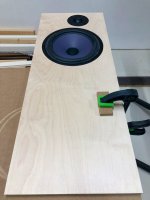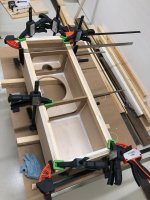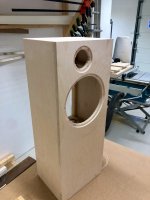the finish is incredible
can you explain a bit how you arrived to such nice finish?
can you explain a bit how you arrived to such nice finish?
Last edited by a moderator:
Yes! Photos, especially low-res ones, are magic.
There are lots of flaws, they just don't show up in the picture. I made the fatal mistake of using a can of varnish that had been open for more than a year, and ended up with little chunks in the dried finish. It also didn't "level" quite as well as it should.
But, since you asked: First I sanded to 400 grit, oiled with Boiled Linseed Oil, applied about 6 layers of shellac to fill the grain, sanded smooth, then applied a tung oil and phenolic resin varnish (Waterlox, in this case).
In the future, I would definitely use a fresh can of varnish, and maybe skip the first two steps.
Or, visa versa, just end with the shellac sanded to 800 grit and wax. This option would not be as shiny, but it would be much smoother and much more "perfect."
Best regards,
John
There are lots of flaws, they just don't show up in the picture. I made the fatal mistake of using a can of varnish that had been open for more than a year, and ended up with little chunks in the dried finish. It also didn't "level" quite as well as it should.
But, since you asked: First I sanded to 400 grit, oiled with Boiled Linseed Oil, applied about 6 layers of shellac to fill the grain, sanded smooth, then applied a tung oil and phenolic resin varnish (Waterlox, in this case).
In the future, I would definitely use a fresh can of varnish, and maybe skip the first two steps.
Or, visa versa, just end with the shellac sanded to 800 grit and wax. This option would not be as shiny, but it would be much smoother and much more "perfect."
Best regards,
John
I've just started my project «SEAS A26 floor stander». Pretty much like the SEAS recommendation, but the height is extended to 85cm. 18mm BB plywood with bracings. Sealed. Approximately 61-liter gross volume.
I'm considering making the rear panel removable - with sealing and screws. It would be easier to experiment with damping material. In addition, I can go for M5 machine screws for attaching the woofer. Any drawbacks?

I'm considering making the rear panel removable - with sealing and screws. It would be easier to experiment with damping material. In addition, I can go for M5 machine screws for attaching the woofer. Any drawbacks?
I made mine with removable backs. It just makes it so much easier to make adjustments.
Almost every speaker I’ve ever made included a removable back, and quite often a removable baffle.
I have read posts from much more experienced builders that suggest that there are no down sides to a removable back—just a little extra work.
I am far from expert, however. Maybe others might chime in.
Almost every speaker I’ve ever made included a removable back, and quite often a removable baffle.
I have read posts from much more experienced builders that suggest that there are no down sides to a removable back—just a little extra work.
I am far from expert, however. Maybe others might chime in.
A transmission line A26 could be a cool idea, or what? I did once have transmission line speakers with the SEAS 25F-EWX. Very tight sounding low end, much like the old Kef Bailey.
I’ve actually heard the A26 at the SEAS factory. Very nice speaker, quite neutral, but a little shy in the low bass. A larger box would of course help.
Speaking of bass - at SEAS they have two very large tapped horn subwoofers on the factory floor, used when they have parties and things like that. If I remember correctly, there are four L26ROY in each. Load enough to tear the building down, as they said.
I’ve actually heard the A26 at the SEAS factory. Very nice speaker, quite neutral, but a little shy in the low bass. A larger box would of course help.
Speaking of bass - at SEAS they have two very large tapped horn subwoofers on the factory floor, used when they have parties and things like that. If I remember correctly, there are four L26ROY in each. Load enough to tear the building down, as they said.
Thanks, glad to hear. What size did you build?I made mine with removable backs. It just makes it so much easier to make adjustments.
Almost every speaker I’ve ever made included a removable back, and quite often a removable baffle.
I have read posts from much more experienced builders that suggest that there are no down sides to a removable back—just a little extra work.
I am far from expert, however. Maybe others might chime in.
I will pursue the idea with removable back panels. Not much extra work either, and it would be easier to convert to ported speakers later on if I find them too lean in my living room. That said, I will prefer a sealed box with an accurate and snappy bass response.
Very interesting, but the sensitivity will be lower, wouldn't it? I use a class A 20W amp and consider going back to tubes. Isn't a transmission line box best for smaller full-tone elements? I have no experience...A transmission line A26 could be a cool idea, or what? I did once have transmission line speakers with the SEAS 25F-EWX. Very tight sounding low end, much like the old Kef Bailey.
Speaking of bass - at SEAS they have two very large tapped horn subwoofers on the factory floor, used when they have parties and things like that. If I remember correctly, there are four L26ROY in each. Load enough to tear the building down, as they said.
Ha-ha! Cool.
Traditionally, transmission lines were used for woofers, usually 10” like KEF, IMF, and TDL. According to PMC, who make such speakers today, transmission lines “… produces higher SPL [sensitivity or loudness] and lower bass extension than ported or sealed box of similar size”.
When I get time for it, I’ll try to simulate a TL version of the A26 with HornResp.
When I get time for it, I’ll try to simulate a TL version of the A26 with HornResp.
Seems to look the part for me. Also beautiful wooden floor underneat and the white background help.Yes! Photos, especially low-res ones, are magic.
There are lots of flaws, they just don't show up in the picture. I made the fatal mistake of using a can of varnish that had been open for more than a year, and ended up with little chunks in the dried finish. It also didn't "level" quite as well as it should.
But, since you asked: First I sanded to 400 grit, oiled with Boiled Linseed Oil, applied about 6 layers of shellac to fill the grain, sanded smooth, then applied a tung oil and phenolic resin varnish (Waterlox, in this case).
In the future, I would definitely use a fresh can of varnish, and maybe skip the first two steps.
Or, visa versa, just end with the shellac sanded to 800 grit and wax. This option would not be as shiny, but it would be much smoother and much more "perfect."
Best regards,
John
With time varnish evaporate, which change it's viscosity, thereby harder to spread.
A transmission line A26 could be a cool idea, or what?
We did this one in the Classic IMF style: http://p10hifi.net/tlinespeakers/FAL/box-plans/classicTL-revisited-WD.pdf
And i just got the specs for a modern ML-TL from Scott.
dave
Wow! I overlooked your post and the gorgeous photo. Sheer beauty! I am really impressed. Morel tweeter?I built these and have been listening to them for a week or so.
Possibly a future project. Did anyone build it?We did this one in the Classic IMF style: http://p10hifi.net/tlinespeakers/FAL/box-plans/classicTL-revisited-WD.pdf
And i just got the specs for a modern ML-TL from Scott.
dave
Dave, did World Design use SEAS A26RE4 in the WD25A kit or was it an earlier design of the woofer? Just curious.
Also for those who make plans, we thank you. But take notes : some shop will have a precision of 1/16 inches max. for the cutting.
That was the case when I go with some plans of the A26.
That was the case when I go with some plans of the A26.
some shop will have a precision of 1/16 inches max. for the cutting
All the plans i do are in mm unless specified as ¾”. Imperial dimensions are conversions for even mm.
Few sheets of materials are exactly their specified thickness. So cut plans will almost always need tweaking.
dave
Nice tapered TL design by @planet10 ! I had speakers virtually exactly like those with a SEAS 25F-EWX. Very tight bass. Not much below 40 Hz though.
I looked at a straight TL for the A26 woofer with HornResp. The TS parameters require a rather long line, but its possible to get flat response to 30 Hz. Will work som more on it, and present the results later.
I looked at a straight TL for the A26 woofer with HornResp. The TS parameters require a rather long line, but its possible to get flat response to 30 Hz. Will work som more on it, and present the results later.
Hi guys. The project is moving forward - slowly but steadily. This is new ground for me, so I'm waiting for some flaws or setbacks...
Both cabinets are glued together. Next up is fine sanding and a few layers of clear Osmo top oil.
Should I add more bracings?
Is a gasket behind the woofer recommended? Nothing to find in the SEAS cardboard box.



Both cabinets are glued together. Next up is fine sanding and a few layers of clear Osmo top oil.
Should I add more bracings?
Is a gasket behind the woofer recommended? Nothing to find in the SEAS cardboard box.



- Home
- Loudspeakers
- Multi-Way
- SEAS A26 Devore Style Build